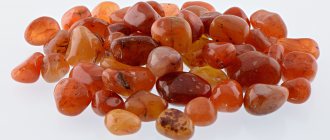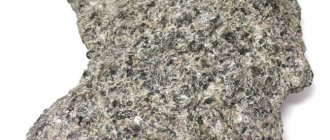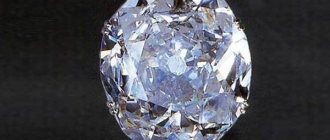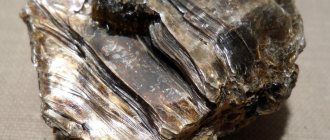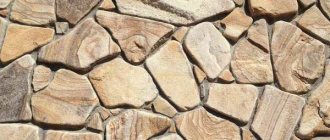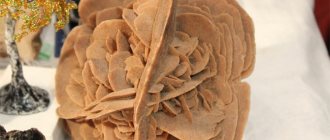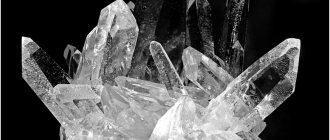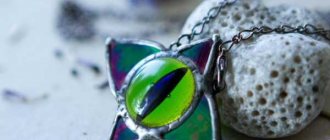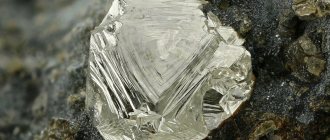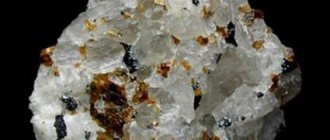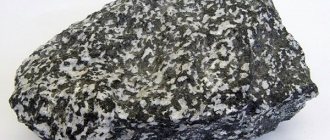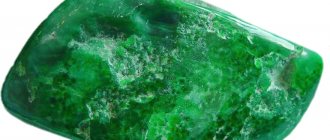| Category | Sedimentary rocks |
| Title in English | Siltstone |
| Formula | To be confirmed |
| Group | Clastic rock group |
| Color | Grey, Dark grey, Brown, Red, Greenish gray |
| Stroke color | To be confirmed |
| Shine | Absent |
| Transparency | Absent |
| singonia | To be confirmed |
| Hardness | Up to 6 on the Mohs scale |
| Cleavage | To be confirmed |
| Density, g/cm³ | 1.8 - 2.6 g/cm³ |
| Kink | Conchoidal |
| origin of name | Siltstone is decomposed into the Greek words ἄλευρον - flour and λίθος - stone. Therefore, the name of the stone is literally translated as petrified flour. This name came to him due to the appearance of the rock. |
| Morphology | This is a cemented rock that is capable of not getting wet. Siltstone is 50% composed of silt-sized particles. |
Siltstone is famous among coal miners. Coal deposits are often located between its layers, or are located on dense sandstone, and are covered with siltstone on top. In addition, the layers of this mineral are often separated by clay and sand.
The structure of siltstone is a dense and hard, cemented material of various colors. When split, it forms fragments of various sizes and shapes with sharp corners.
— Advertising —
Widely used in construction work.
Siltstone deposits
In the middle of the last century, siltstone mining was carried out in the mines of the Krasnoyarsk Territory (Russia).
At the moment, the mines are flooded, and the resulting lakes have eliminated access to the deposits. Now siltstone is mined in the Republic of Karelia, where there are quarries with deposits of this mineral. This is where samples of rich red and purple colors are found.
The area where it is planned to mine siltstone is always carefully checked by specialist geologists and provides relevant documents on the radiation and hygienic condition of the site. This is due to the growing popularity of siltstone in decorative applications and the need to comply with radioactive safety.
Prices for argillite products
The cost of argillite or jewelry and crafts made from it is related to the quality and weight of a particular product. The simplest talismans and amulets are priced at a few dollars, while more complex products in terms of price depend on the work of the craftsman and other materials used.
History of siltstone
— Advertising —
From the Greek, the word “aleurone” is translated as “flour,” that is, the name of the stone is translated as “petrified flour” or “mealy.”
The formation of siltstone in nature is a long and difficult process. The first stage involves caking and compacting of very fine sand mixed with clay or silt to form silt. This process occurs over millions of years as rock layers compress bulk materials, turning them into stone.
Over time, under the influence of high temperatures and pressure, the silt changes, the silicon compounds melt and combine into grains, the clay also becomes more dense and forms mudstone. But the minerals do not melt completely. Next, the siltstone layer rises due to tectonic movement and cools.
At the stage of direct mineral extraction, full-fledged layers of siltstone are exposed: cemented, compacted rock of gray, black, red-brown or greenish color.
What is the origin
Its formation begins with silt deposits mixed with clay dust and tiny grains of sand. Under the mass of layers of new silts, the bulk material cakes and is transformed into a fairly hard intermediate material - siltstone. It takes millions of years to accumulate and compact it. The deeper the silt sinks into the depths, the more it is affected by rising temperatures and increasing pressure. This increasing impact completes the transformation of the bulk mixture into a more durable material that is resistant to various impacts. Silts and siltstones are often, but not always, adjacent to coal seams. Often they are adjacent to other clayey rocks that appeared by sedimentation.
Physico-chemical characteristics of siltstone
The chemical composition of siltstone is intermediate between sandstone and clay.
It has a higher silica content, but less aluminum oxide, potassium and water than clay, but not as much silica as sandstone. Rare specimens are formed from quartz silt without impurities. Mica, chlorite, feldspar, carbonates and iron compounds were also found in most samples. Siltstone deposits are either an earthy mass that easily forms powder, or a dense cemented structure with a conchoidal fracture. The structure is layered, with fibers. The color range of a mineral is determined by the impurities that are included in its composition. Light shades predominate: gray, greenish, yellowish.
Natural stone is a very valuable building material, as it is highly strong, durable and beautiful. In construction, it is used for cladding premises.
Accepted abbreviations: Page – structure. Text. – texture. Min. composition – mineral composition. Exc. signs are distinctive features.
Siltstone
Name “silt forest”, based on the predominant content of dust particles (fraction 0.05–0.005 mm); group – half-rock; type in terms of material composition – silicate. Color: grey, dark grey, brown, brownish or greenish. Page: fine-grained to cryptocrystalline; according to the predominant content of dusty particles invisible to the eye from 0.05 to 0.005 mm - silty (siltstone). Text: homogeneous, layered, sometimes porous. Min. composition: consists of finely crushed grains of quartz, feldspar, clay minerals, sometimes carbonates (reaction with hydrochloric acid) and ferruginous minerals (yellow or brown color) are present. Exc. signs: the smell of clay when the sample is moistened with breath; uneven fracture and lack of foliation - unlike shales; hard, scratches glass - unlike argillite; fine-grained or cryptocrystalline - unlike sandstones; relatively heavy – in contrast to lighter and denser flasks. Origin: formed during the cementation of dispersed sedimentary silty soils - loess, loess-like soils (sandy loam and loam). Application: in the absence of other soils, it is used in the construction of highways as coarse soils during the construction of subgrades; in civil engineering it is used as coarse soil for bedding and embankments; is prone to rapid weathering in excavations and pits, where it, like mudstone, breaks up into platy or foliated units, acute-angled crushed stone and debris, and ultimately weathers to sandy loam and loam.
Anhydrite
The name comes from “an” - negation, “hydro” - water, in Russian anhydrous, which indicates the absence of water in it, unlike gypsum; group – half-rock; type in terms of material composition – sulfate. Color: generally light with varying shades, often slightly bluish. Page: holocrystalline, sometimes cryptocrystalline (looks like porcelain). Text: homogeneous. Min. composition: consists of anhydrite mineral - white line, hardness 3.5 (does not scratch glass, scratches nails). Exc. signs: cannot be scratched with a fingernail – unlike plaster; does not react with hydrochloric acid - unlike rocky and semi-rocky sedimentary soils of carbonate composition and marbles. Origin: formed by precipitation as salt in water basins; during dehydration of gypsum under conditions of elevated pressure and temperature; found together with gypsum in salt deposits and sandy-clay deposits. Application: in construction it is used as a binding material for flooring, as a material for plastering and masonry cement; sometimes used as a decorative material and used instead of marble; when used as a base and medium for engineering structures, it is dangerous - it swells when moistened and turns into gypsum.
Argillite
The name comes from the Greek “argilles” - dense clay; group – rocky; type in terms of material composition – silicate. Color: gray, dark gray to black, less often brown, greenish. Page: cryptocrystalline; according to the predominant content of clay minerals invisible to the eye (less than 0.005 mm in size) – clayey (pelitic). Text. : homogeneous, thin-layered. Min. composition: the main minerals are clay minerals (soft, can be scratched with a fingernail, and slide on the glass), quartz and feldspar (the presence is determined by individual scratches on the glass, with the general sliding of the sample along it). Exc. signs: smell of clay when moistened by breath; glides across glass leaving shallow scratches - unlike siltstones; uneven fracture and lack of foliation - unlike shales; does not get wet in water and does not have plasticity - unlike clays and loams. Origin: formed during cementation of dispersed sedimentary clay soils - loams, clays. Application: in the absence of other soils, it is used in the construction of highways as coarse soils during the construction of subgrades; in civil engineering it is used as coarse soil for bedding and embankments; is prone to rapid weathering in excavations and pits, where it, like siltstone, breaks up into platy or leafy units, acute-angled crushed stone and debris, and ultimately weathers quite quickly to loams and clays.
Asphalt
The name comes from the Greek “asphaltos” - resin; According to the conditions of formation, it belongs to organic sedimentary soils. Color: from dark gray to black, dark brown. Page: organogenic; grains of the mineral base are practically indistinguishable, sometimes sand particles and larger fragments are visible. Text: homogeneous. Min. composition: is a mixture of partially oxidized hydrocarbons, often containing admixtures of sand particles and other larger fragments of various rocks and minerals. Exc. signs: glassy luster; light – density 1.0–3 g/cm3; hardness 1–2; the line is black or brown; melts easily in the flame of a match - unlike coals. Origin: formed during the oxidation of oil; found in fractured sandstones. Application: in construction it is used as coating waterproofing, emulsions and as a valuable organic binder for road surface materials.
Breccia
The name comes from the Italian “breccia” - crushed stone; group – rocky; type in terms of material composition – silicate. Color: varied, determined by the color of the debris and cement. Page: coarse-grained (psephitic) – consists of unrounded, angular, irregularly shaped fragments ranging in size from 2 to 200 mm or more. Text: homogeneous. Min. composition: varied, determined by the material composition of the fragments (minerals, rocks); difficult to detect visually in samples. Exc. features: unrounded, angular fragments in the sample - unlike conglomerates and gravelites; the sample contains more fragments than the cement holding them together - unlike tuffs; absence of traces of crushing and deformation - unlike tectonic breccias; reacts with hydrochloric acid, the sample shows fragments and cement holding them together (carbonate composition) - unlike limestones and marls. Origin: formed during the cementation of blocky, crushed stone and wood deposits. Application: in construction it is widely used as a building and facing stone, while easily processed breccias of carbonate composition are more preferable.
They are distinguished as varieties: carbonate (karst) breccias - formed from unrounded fragments of soils of carbonate composition in the zone of action of underground flows, in places where karst processes occur (glass is not scratched).
Halite
The name is from the Greek “gals” - sea, salt; group – half-rock; type in material composition - halogen. Color: colorless, white, red, gray, blue. Page: full-crystalline, rarely cryptocrystalline (confluent). Text: uniform, spotted, banded. Min. composition: main mineral halite (white line, hardness 2, cleavage perfect in three directions, salty taste). Exc. characteristics : easily soluble in water; salty taste – difference from sylvinites. Origin: formed by the evaporation of water from aqueous solutions (sea basins and salt lakes) and as a result of movement in soil masses along pores and cracks under pressure; found in dispersed form in dispersed sandy and clayey soils (saline soils). Application: used in road construction to combat ice and as a medium for the disposal of radioactive waste; When using saline soils as foundations and materials for earthworks, it is necessary to take into account that they lose strength when moistened with water.
Gypsum
The name comes from the Arabic “gebas” - white or from the Greek “gypsos” - chalk, gypsum; group – half-rock; type in terms of material composition – sulfate. Color: varied, usually white, yellowish or pinkish. Page: holocrystalline, fibrous, sometimes cryptocrystalline. Text: homogeneous, sometimes banded in fibrous varieties of gypsum. Min. composition: predominantly monomineral, consist of gypsum (white streak, glassy or silky to pearlescent luster, scratchable with a fingernail). Exc. signs: partially soluble in water; scratches with a fingernail - unlike anhydrites. Origin: formed from solutions in water basins, alternating with other salts and sandy-clay deposits; may also be present in a dispersed state in dispersed sedimentary soils. Application: widely used in construction as a plaster material and light building stone; gypsum in the form of alabaster is used to make sculptures; when used as foundations for engineering structures, it is dangerous because it is dissolved by groundwater with the formation of voids and caves (karst processes and phenomena).
There are varieties of gypsum: alabaster - fine-grained, marble-like gypsum, translucent at the edges; fibrous gypsum (selenite) – white or yellowish-pink; silky shine; fibrous structure.
Gravelite
see conglomerate.
Diatomite
The name comes from the shells of diatoms (siliceous algae) that compose it; group – half-rock; type in material composition – siliceous. Color: white, gray or pink. Page: cryptocrystalline, fine-grained. Text: homogeneous, sometimes thin-layered. Min. composition: the main mineral is opal, as well as clay minerals, quartz, remains of diatoms, radiolaria, sponges. Exc. characteristics: light color, soft to the touch, very light, finely porous (absorbs water and acid); looks like earthy aggregates (crumbs in your hands like chalk); sticks to the tongue, gets your hands very dirty, does not scratch the glass (see mineral composition - siliceous minerals), light-colored powder and rare scratches remain on the glass - unlike flask stones, mudstones, siltstones; absorbs hydrochloric acid without reaction - unlike chalk, limestone, marls; similar to tripoli, from which diatomite cannot be distinguished with the naked eye. Origin: formed mainly from the remains of algae - diatoms, radiolarians, sponges mixed with clay and siliceous material when they die and are deposited on the bottom of seas, less often lakes. Application: used in industry for the purification of various products as a catalyst, filler, adsorbent, etc.
Dolomite
Named after the French mineralogist Dolomier; group – rocky; type in terms of material composition – carbonate. Color: white, gray, often yellowish. Page: medium- to fine-grained, sometimes cryptocrystalline (porcelain-like). Text: uniform, less often spotted and patterned. Min. composition: consists of dolomite (reaction with hydrochloric acid in powder), the presence of calcite, anhydrite, and clay minerals is often noted. Exc. signs: white line, does not scratch glass; reacts with cold hydrochloric acid in powder - unlike limestones, marls, anhydrites. Origin: one point of view on the origin is organogenic limestones, which, during compaction, gradually turned into dolomite when exposed to magnesian solutions. Application: durable dolomites are used as crushed stone in road construction and as a valuable building material, raw material for the manufacture of refractory bricks; when used as a base and as a medium during the construction of engineering structures, it is very dangerous, as it is dissolved by groundwater with the formation of cavities, voids and caves (karst formation).
Limestone
The name comes from the word lime; group – rocky; type in terms of material composition – carbonate. Color: varied, from pure white to black. Page: cryptocrystalline, sometimes detrital, organogenic. Text: homogeneous, thin-layered, porous. Excellent: signs: glass does not scratch - unlike flasks; reaction with hydrochloric acid in a piece - unlike dolomites; reaction with hydrochloric acid in a piece without a brown coating at the site of reaction (residues of unreacted clay minerals) - unlike marls; reaction with hydrochloric acid in the piece and the absence of fragments in the sample - in contrast to carbonate breccias and conglomerates. Origin: according to the conditions of formation, they can be chemical, such as oolitic limestone, dense limestone (formed from supersaturated solutions); organogenic, such as shell limestone, chalk, coral limestone (formed during the cementation of sediments from shells, coral skeletons, and organisms); mixed, such as clayey limestones (formed from supersaturated solutions when calcite precipitates along with clay minerals), bituminized (impregnated with bitumen), etc. Application: is a valuable building material; durable limestones are used as building stone in civil engineering and as crushed stone in road construction; calcareous tuff (travertine) is used as a thermal insulation, finishing, and decorative material; limestone is used in large quantities as a raw material for the production of cement and building lime; when used as a base and as a medium during the construction of engineering structures, it is very dangerous, as it is dissolved by groundwater with the formation of cavities, voids and caves (karst formation).
The following varieties are distinguished: dense limestone - characterized by a homogeneous, dense composition; oolitic limestone – consists of concentric, shell-like balls (oolites) of carbonated lime, cemented with calcareous-clay cement; limestone-shell rock - consists of mollusk shells and the remains of small marine animals, porous; coral limestone – consists of coral polyps, homogeneous; calcareous tuff - large-porous limestone, from which fine-grained, durable, grindable and polishable travertine is distinguished as its variety; chalk is a porous limestone of marine origin, consisting of tiny, invisible shells and shells of microscopic algae; the aggregates are earthy, gets your hands dirty; Clayey, bituminous and other limestones are distinguished according to the composition of impurities, conditions of formation, etc.
Conglomerate
The name comes from the Latin “conglomero”, accumulated, collected; group – rocky; type in terms of material composition – silicate. Color: varies, depending on the color of the debris and cement. Page: coarse-grained (psephitic), made of rounded fragments ranging in size from 2 to 200 mm or more. Text: homogeneous. Min. composition: varied, determined by the material composition of the fragments (minerals, rocks); difficult to detect visually in samples. Exc. features: rounded fragments in the sample – unlike breccias; the sample contains more fragments than the cement holding them together - unlike tuffs; reacts with hydrochloric acid, the sample shows fragments and cement holding them together (possibly of a carbonate composition) - unlike limestones and marls. Origin: formed during the cementation of boulder, pebble and gravel deposits. Application: in construction it is widely used as building and facing stone.
They are distinguished as varieties: gravelites - conglomerates with a predominance of rounded fragments ranging in size from 2 to 10 mm (gravel); carbonate (calcareous) conglomerates – formed from rounded fragments of soils of carbonate composition.
Marl
The German name combines sedimentary rocks consisting of clay and carbonates, the exact name is determined by the ratio of clay particles, dolomite and limestone; group – half-rock; type in terms of material composition – carbonate. Color: light gray, gray, dark gray, brown, black (determined by the color of the clay substance). Page: cryptocrystalline, fine-grained. Text: homogeneous, layered. Min. composition: consists of calcite up to 50%, sometimes dolomite and clay minerals (reacts with hydrochloric acid in the piece). Exc. signs: emits a clay smell when moistened by breath; sticks to tongue; sometimes the samples contain remains of flora and fauna, rock fragments; the presence of iron oxides and hydroxides is detected by a yellow, brown, brown color; dirty brown coating at the site of reaction with hydrochloric acid - unlike limestone and chalk; glass does not scratch, it reacts with hydrochloric acid - unlike flask stones, mudstones, and siltstones. Origin: formed by the precipitation of calcite minerals and clay particles or a mixture of clay particles with the products of abrasion of shells in seas and lakes. Application: marls are a valuable raw material for the production of cement; when using marl as a material for embankments of highways and bedding, there is a need to experimentally test its suitability, since it easily weathers, cracks, loosens and disintegrates into angular crushed stone and debris (justifies its old name - rubble); when used as a base and as a medium during the construction of engineering structures, it is very dangerous, as it is dissolved by groundwater with the formation of cavities, voids and caves (karst formation).
They distinguish as a variety clayey marl, marl with a content of clay minerals from 50 to 70%.
Flask
The name is Polish, as porous siliceous rocks are called; group – half-rock; type in material composition – siliceous. Color : grayish-white, yellowish or yellowish-brown, to black. Page: cryptocrystalline, fine-grained Text: homogeneous. Min. composition: consists of opal mineral cemented with silica (scratches glass); clay minerals, quartz, and microorganism residues may be present as impurities. Exc. signs: light, on impact it breaks into sharp-angled fragments with a conchoidal fracture, sticks to the tongue; scratches glass, does not react with hydrochloric acid - unlike limestones, marls, dolomites; dense, lightweight rock that hardly stains your hands - unlike tripoli and diatomites; relatively light, often lighter - unlike mudstones and siltstones; When fragments of a rock sample rub against each other, the grains do not crumble - unlike sandstones. Origin: formed in marine basins due to compaction and cementation of diatomites and tripoli. Application: in construction it is sometimes used as a building stone.
Sandstone
The name is derived from sand; group – rocky and semi-rocky; type in terms of material composition – silicate. Color: different, depends on the color of the cement and grains of minerals that make up the soil. Page: fine-clastic (psammitic) – consists mainly of particles of the sand fraction ranging in size from 0.05 to 2 mm. Text: homogeneous, layered, porous. Min. composition: consists of quartz, feldspar, mica, glauconite, while any of them can prevail over the others and determine the properties of sandstone; The presence of ore minerals (magnetite, hematite, limonite), clay and other minerals is often observed. Exc. signs: in any sandstone, sand particles ranging in size from 0.05 to 2 mm are always visible - in contrast to breccias, conglomerates, gravelites, siltstones, mudstones; the sample shows grains of approximately the same size and shape - in contrast to volcanic tuffs and tuffites; When the fragments rub against each other, the grains crumble—unlike quartzites and opokas. Origin: formed during the cementation of sandy deposits of various origins and conditions of formation. Application: when used in construction, special testing of sandstone is necessary for its suitability as a material in accordance with state requirements. standard; in construction it is used as building and facing stone; in road construction it is used as crushed stone.
According to the predominant content of main minerals, varieties are distinguished: quartz sandstone - consists of quartz (the shine of rounded convex grains is from glassy to greasy, scratches glass with a characteristic crack); micaceous sandstone – consists mainly of small flakes of mica; glauconite sandstone - consists mainly of grains of the green, bluish-green mineral glauconite, which contains copper compounds; arkose sandstone – consists of feldspars and quartz (matte shine due to the predominance of feldspar); clayey sandstone (greywacke) – consists of various minerals and fragments; grains, as a rule, have a size of less than 1 mm; color dark gray with greenish tints; texture is uniform, often layered; when you move your fingers along the grain pattern, the particles are chipped; bituminous sandstone – sandstone with bitumen-based cement (black color); calcareous sandstone - sandstone with carbonate-based cement (reacts with hydrochloric acid, sand particles are visible that scratch glass - unlike limestones and marls); siliceous sandstone - sandstone with silica-based cement (very durable, smooth on the surface, scratches glass and therefore is a transitional soil to quartzites); ferruginous sandstone - sandstone with cement based on iron oxides and hydroxides (differs in color - yellow, brown, brown and red in streaks); gypsum sandstone - sandstone with gypsum-based cement (the cement is soft - scratched with a fingernail).
Silvinite
Named after the chemist Silvio de la Basche; group – half-rock; type in material composition - halogen. Color: from white to gray with a reddish tint, sometimes red. Page: crystalline. Text: homogeneous, layered in outcrops. Min. composition: consists of the mineral sylvite, sometimes with admixtures of clay minerals, halite, carbonates, etc.; the line is white; gloss from glassy to greasy; hardness 2.5. Exc. signs: bitter-salty taste - unlike halite. Origin: formed when salts precipitate in sea and lake basins, as well as during subsequent movement in rocks under pressure. Application: not used in construction.
Trepel
The name is from the German “tripol”; group – half-rock; type in material composition – siliceous. Color: light gray, grayish, yellowish, less often dark gray. Page: fine-grained, cryptocrystalline. Text: homogeneous, layered, finely porous. Min. composition: consists of the smallest grains of opal, clay minerals, quartz, etc.; This rock is similar in physical and chemical properties to diatomite (it differs from it in the absence of organic residues) and therefore it is impossible to visually distinguish it from diatomite. Exc. characteristics: soft to the touch, very light, finely porous (absorbs water and acid); in appearance - earthy aggregates, sticks to the tongue, gets very dirty on the hands, does not scratch glass (see mineral composition - siliceous minerals), light-colored powder and rare scratches remain on the glass - unlike flask stones, mudstones, siltstones; absorbs hydrochloric acid without reaction - unlike chalk, limestone, marls; looks like diatomite, from which it is impossible to distinguish tripolite with the naked eye. Origin: formed during the sedimentation of siliceous algae in sea basins. Application: in construction it is used as a thermal insulation material and as a hydraulic additive in cement.
Calcareous tuff
See limestone.
Siliceous tuff
The name is from the Italian "tufo"; subgroup rocky; type in material composition – siliceous. Colour: generally light; the color changes according to the pattern. Page: cryptocrystalline. Text: homogeneous, often unclearly layered, variegated. Min. composition: consists of siliceous compounds (glass scratches). Exc. features: dense, unclearly layered with caverns; It does not react with hydrochloric acid, it scratches glass - unlike calcareous tuffs. Origin: formed on land and in the sea from silica during volcanic eruptions, as well as during the deposition of silica within hot springs of mineralized groundwater. Application: in construction it is used as a building stone, sometimes as a decorative stone, and more often as an ornamental stone (banded, patterned varieties).
Tuffit
The name is derived from tuff; group – rocky; type in terms of material composition – silicate. Color: generally light in color, with color varying according to pattern. Page: clastic (psammitic, psephyto-psammitic) – consists of fragments of various sizes and origins; fragments of sedimentary origin - rounded), volcanic - sinuous irregularly shaped lapilli, sand particles and ash; fragments of intrusive rocks - irregular in shape. Text: homogeneous or unclearly layered, porous. Min. composition: consists of minerals of sedimentary and igneous rocks, difficult to detect in a sample with the naked eye. Exc. characteristics: in terms of the percentage of volcanogenic formations from 50 to 90% (lapilli, sand and ash) in the sedimentary material, it differs from volcanic tuffs (more than 90%), tuff sandstones and tuff siltstones (from 20 to 50%); angularity, tortuosity of fragments and grains, their unsorted nature - unlike sandstones. Origin: formed in places of volcanic eruptions during the cementation of eruption products (lapillas, sand particles, ash) and pre-existing sedimentary deposits. Application: used in construction as a facing and wall thermal insulation material.
Coals
Organogenic rocks (caustobiolites). Color: brown to black, with or without shine. Page: earthy, granular, organogenic. Text: homogeneous, layered, banded. Min. composition: mainly consists of plant residues, carbon, quartz, clay minerals and admixtures of resinous substances. Exc. signs: solid combustible rocks; gloss from matte to metallic; All coals burn at a high temperature, but do not melt - unlike asphalt. Origin: formed during the coalification of plant residues without access to atmospheric oxygen, for example, under the cover of sandy or silty-clayey rocks. Application: in construction it is used as fuel, combustible material for fires. There are different types of coals: brown coals - matte to resinous luster, brown line color, very dirty on hands, does not contain plant residues, but retains their imprints. stone coals - matte to glassy shine, black line color, stains hands; anthracite – strong metallic luster, conchoidal fracture, does not stain hands.
**** Source: Determination of sedimentary rocks (rocky and semi-rocky): Guidelines for the implementation and design of laboratory work No. 3 for students of construction and road specialties of all forms of study / Comp. N. I. Gorshkov. – Khabarovsk: Khabar Publishing House. state tech. University, 2002. – 27 p.
Types of siltstone
Based on the size of the silicate grains that make up the siltstone, the mineral is classified into large, small and mixed-grained.
Depending on the cement that holds the grains of sand together, clayey, calcareous-clayey and ferruginous siltstones are distinguished.
According to another classification, siltstones are distinguished:
- Sandstones - layers reach sizes from 200 to 500 meters. They lie at a depth of 900 to 1100 m. The thickness of the clay layer in this variety is relatively small, 3-7 m. It is located between layers of rocks 30-40 m high.
- Clayey - when buried at great depths, a clayey adhesion is formed in the stone. The composition is mixed, more like clay, includes loam, sandy loam, and is sometimes classified as a transitional rock.
Mudstone colors
Despite the origin and relationship with clays, the color range of argillite is quite wide: from light to dark tones. Thus, even the ancient peoples knew red argillite, which the Indians used to paint their bodies by grinding the mineral into fine dust, and the inhabitants of Australia used white or grayish argillite for the same purposes.
The healing properties of siltstone
Almost nothing is known about the healing properties of siltstone. But sculptures and amulets based on it look beautiful and calm. Therefore, they are recommended to be placed in the house as a preventive measure against troubles in the field of physical and mental health.
Argillite and zodiac sign
Argillite obeys the Moon in the last phase, and it is its power that it imparts to its owner.
First of all, he patronizes the zodiac signs of the air element: Libra, Aquarius, Gemini and the water element: Cancer, Scorpio, Pisces. Its action for these people is aimed at strengthening and helping to reveal innate talent and hidden capabilities, including witchcraft, prophecy and fortune telling. Taurus, Capricorn and Virgo, as earth signs, will also experience the powers of the stone, but only on the waxing Moon and until the full moon.
Argillite is not recommended only for representatives of the fire element (Leo, Sagittarius, Aries). He attracts unpleasant situations, sorrows and illnesses to them.
Industries of application of siltstone
Valuable varieties of siltstone are those that are characterized by attractive optical cleavage properties.
With a fine-grained structure of the stone, the chip not only becomes rough, but also becomes capable of changing the reflected light. The most popular variety is siltstone, which has a blue-violet glow against a general background of warm color. Also valuable is the species that, under artificial lighting, plays with the color of sea waves. Such beautiful siltstones are very rare. They are found exclusively in Karelia.
Not so variegated and bright, but more durable, siltstones are used for garden paths and decorative compositions, in roofing work, for cladding buildings, and also in road construction.
The use of siltstone depends on the resistance of the variety to weather conditions. Thus, some varieties can lose strength from getting wet or freezing even at one time. Therefore, a stone of appropriate quality is selected for different purposes.
The magical properties of argillite
In magical circles, mudstones are known as "stop stones." This mineral is able to stop a wide variety of processes and stop the rapid flow of energy. For this reason, talismans and amulets made from argillites are recommended exclusively for hyperactive people. But at the same time, mudstones are not destructive minerals; they resist active actions, but help in contemplative concentration. With their help, the thought process becomes deep, insight increases and it becomes easier to understand the essence and meaning of current events. Argillite amulets also have the ability to transform insight into a real gift of clairvoyance.
How to distinguish real siltstone from fake
Siltstone is often confused with sandstone (pictured), but they are more dense.
Outwardly, it is very difficult to distinguish the adjacent layers of sandstone and siltstone; the rocks are similar to each other, there are no clear transitions between them. Sandstone can be distinguished from siltstone by the shape of their silicate grains. Thus, in sandstones they consist of rounded, rounded grains of sand that have been moved for a long time by water or air, while fragments of quartz and other minerals that make up siltstone are angular and pointed.
In addition, the color of siltstone is usually brighter and more saturated due to the content of clay cements. Although over time, due to the influence of highly mineralized groundwater on the rock, the original color fades. And in regions where iron ores and sandstones occur, siltstones are colored red.
Argillite in the ancient world
As already mentioned, the mineral has been known since ancient times.
Its processing began at a time when people had minimal knowledge and means of processing stones. Near Alaska there is an archipelago called the Queen Charlotte Islands. The Haida tribe lived there. It is also noted that this is an extensive mudstone deposit.
The local mineral became available because the soil pressed it to the surface as an extremely hard substance. Of course, the Indians did not develop the breed, but only collected it in accessible places.
The Indians became famous for processing black and red mudstone; it was used to create the so-called peace pipes for smoking.
This is where one of the side names came from – hailite, mentioned earlier. The fact is that the locals succeeded in processing this material.
Many items were found, some of which received high marks from experts.
First of all, these are ritual attributes, amulets, jewelry, household appliances, fixtures and more.
Scientists believe that these tribes are not only the ancestors, but also the first processors of argillite.
Of course, in the modern world, not such heights have been achieved, technology continues and develops, but everywhere there is a beginning, a source.
Products made from argillite are currently stored in museums and private collections.
They cost impressive sums, despite the fact that the material itself does not have any special value. It's ancient history now.
Interesting facts about siltstone:
- Siltstone is not nearly as durable a stone as granite. Nevertheless, it is used in finishing works, firstly, because the rock deposits are arranged in a layered manner and are convenient for mining, and siltstone has also proven itself well as a tile material. The color palette of the mineral makes it possible to create interesting decorative effects on buildings and premises. Siltstone is also very convenient to work with, it is easy to cut and polish.
- Many houses in St. Petersburg were built using siltstone. The famous St. Isaac's Cathedral is also lined with this stone.
- Unique siltstone deposits are located in Karelia; they are colored in various shades of pink, cherry, and purple. The processed slabs are truly luxurious; the image on them resembles water ripples.
What are the properties of this mineral?
- They have excellent frost resistance. Do not crack during sudden temperature changes.
- Does not exhibit dangerous radioactivity. All samples undergo radiation and hygienic assessment before reaching construction sites and becoming luxurious finishes. It is carried out by specialists from metrological centers and the Institute of Geology.
- Density, measured in g/cm3, ranges from 1.8-2.8.
- Mohs hardness within 6 points is determined by the fact that siltstones are capable of scratching glass.
- The difference in water absorption rates of siltstones of different origin and composition is 0.2-0.45%. Only those varieties that are not washed away by water are suitable for use.
Wear-resistant material, hard and abrasion resistant. Durable enough to withstand heavy loads for a long time.- Has good chemical resistance.
- The luxurious stone coating is surprisingly easy to maintain. Any dirt can be easily removed from its surface.
- Aesthetic properties are manifested in the richness of the natural palette. Designers often use different natural shades to create the most interesting and effective compositions.
- It cuts perfectly, can be polished and sanded.
- Natural colors do not fade or lose their richness under the influence of extreme heat or significant sub-zero temperatures. Their intensity does not disappear under the sun's rays.
